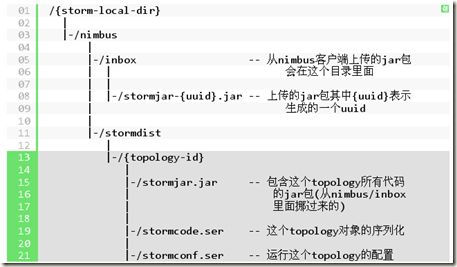Storm-源码分析-Topology Submit-Nimbus
Nimbus Server
Nimbus server, 首先从启动命令开始, 同样是使用storm命令"storm nimbus”来启动
看下源码, 此处和上面client不同, jvmtype="-server", 最终调用"backtype.storm.daemon.nimbus"的main
nimbus是用clojure实现的, 但是clojure是基于JVM的, 所以在最终发布的时候会产生nimbus.class, 所以在用户使用的时候完全可以不知道clojure, 看上去所有都是Java
clojure只是用于提高开发效率而已.
def nimbus(): """Syntax: [storm nimbus] Launches the nimbus daemon. This command should be run under supervision with a tool like daemontools or monit. See Setting up a Storm cluster for more information. (https://github.com/nathanmarz/storm/wiki/Setting-up-a-Storm-cluster) """ cppaths = [STORM_DIR + "/log4j", STORM_DIR + "/conf"] childopts = confvalue("nimbus.childopts", cppaths) + " -Dlogfile.name=nimbus.log -Dlog4j.configuration=storm.log.properties" exec_storm_class( "backtype.storm.daemon.nimbus", jvmtype="-server", extrajars=cppaths, childopts=childopts)
launch-server!
来看看nimbus的main, 最终会调到launch-server!, conf参数是调用read-storm-config读出的配置参数,
而nimbus是INimbus接口(backtype.storm.scheduler.INimbus)的实现, 可以参考standalone-nimbus
(defn -main [] (-launch (standalone-nimbus)))
(defn -launch [nimbus] (launch-server! (read-storm-config) nimbus)) (defn launch-server! [conf nimbus] (validate-distributed-mode! conf) (let [service-handler (service-handler conf nimbus) options (-> (TNonblockingServerSocket. (int (conf NIMBUS-THRIFT-PORT))) (THsHaServer$Args.) (.workerThreads 64) (.protocolFactory (TBinaryProtocol$Factory.)) (.processor (Nimbus$Processor. service-handler)) ) server (THsHaServer. options)] (.addShutdownHook (Runtime/getRuntime) (Thread. (fn [] (.shutdown service-handler) (.stop server)))) (log-message "Starting Nimbus server...") (.serve server)))
1. service-handler
首先定义service-handler, service-handler前面的定义如下
(defserverfn service-handler [conf inimbus]
(reify Nimbus$Iface
...)
)
这边用到一个macro定义defserverfn, 如下
(defmacro defserverfn [name & body] `(let [exec-fn# (fn ~@body)] (defn ~name [& args#]0 (try-cause (apply exec-fn# args#) (catch InterruptedException e# (throw e#)) (catch Throwable t# (log-error t# "Error on initialization of server " ~(str name)) (halt-process! 13 "Error on initialization") )))))
定义匿名函数 fn[conf inimbus] (……)
定义函数defn service-handler [& args], 里面只是简单的调用fn…使用这个macro和直接定义defn service-handler [conf inimbus]几乎没有啥区别
我有个疑问, 为什么要定义这个无聊的macro, 难道就是为了便于后面的exception处理
2. server
其中processor, 是server上主要的处理进程, 使用传入的service-handler进行数据处理
Nimbus$Iface
Nimbus server已经启动, 剩下就是处理从client传来的RPC调用, 关键就是Nimbus$Iface的实现
在下面的实现中总是用到nimbus这个变量, nimbus-data, 用于存放nimbus相关配置和全局的参数
let [nimbus (nimbus-data conf inimbus)]
(defn nimbus-data [conf inimbus] (let [forced-scheduler (.getForcedScheduler inimbus)] {:conf conf :inimbus inimbus :submitted-count (atom 0) ;记录多少topology被submit :storm-cluster-state (cluster/mk-storm-cluster-state conf) ;抽象Zookeeper接口(Zookeeper用于存放cluster state) :submit-lock (Object.) ;创建锁对象,用于各个topology之间的互斥操作, 比如建目录 :heartbeats-cache (atom {}) ;记录各个Topology的heartbeats的cache :downloaders (file-cache-map conf) :uploaders (file-cache-map conf) :uptime (uptime-computer) :validator (new-instance (conf NIMBUS-TOPOLOGY-VALIDATOR)) :timer (mk-timer :kill-fn (fn [t] (log-error t "Error when processing event") (halt-process! 20 "Error when processing an event") )) :scheduler (mk-scheduler conf inimbus) }))
接着重点看下submitTopology,
4个参数,
^String storm-name, storm名字
^String uploadedJarLocation, 上传Jar的目录
^String serializedConf, 序列化过的Conf信息
^StormTopology topology, topology对象(thrift对象), 由topologyBuilder产生
(^void submitTopology [this ^String storm-name ^String uploadedJarLocation ^String serializedConf ^StormTopology topology] (try (validate-topology-name! storm-name) ;;名字起的是否符合规范 (check-storm-active! nimbus storm-name false) ;;check是否active (.validate ^backtype.storm.nimbus.ITopologyValidator (:validator nimbus) ;;调用用户定义的validator.validate storm-name (from-json serializedConf) topology) (swap! (:submitted-count nimbus) inc) ;;submitted-count加1, 表示nimbus上submit的topology的数量 (let [storm-id (str storm-name "-" @(:submitted-count nimbus) "-" (current-time-secs)) ;;生成storm-id storm-conf (normalize-conf ;;转化成json,增加kv,最终生成storm-conf conf (-> serializedConf from-json (assoc STORM-ID storm-id) (assoc TOPOLOGY-NAME storm-name)) topology) total-storm-conf (merge conf storm-conf) topology (normalize-topology total-storm-conf topology) ;;规范化的topology对象 topology (if (total-storm-conf TOPOLOGY-OPTIMIZE) (optimize-topology topology) topology) storm-cluster-state (:storm-cluster-state nimbus)] ;;操作zk的interface (system-topology! total-storm-conf topology) ;; this validates the structure of the topology, 1. System-topology! (log-message "Received topology submission for " storm-name " with conf " storm-conf) ;; lock protects against multiple topologies being submitted at once and ;; cleanup thread killing topology in b/w assignment and starting the topology (locking (:submit-lock nimbus) (setup-storm-code conf storm-id uploadedJarLocation storm-conf topology) ;;2. 建立topology的本地目录 (.setup-heartbeats! storm-cluster-state storm-id) ;;3. 建立Zookeeper heartbeats (start-storm nimbus storm-name storm-id) ;;4. start-storm (mk-assignments nimbus))) ;;5. mk-assignments (catch Throwable e (log-warn-error e "Topology submission exception. (topology name='" storm-name "')") (throw e))))
1. System-topology!
Validate Topology, 比如使用的comonentid, steamid是否合法
添加系统所需要的component, 比如acker等, 不过没有用到, 不知道为什么要调用System-topology!
(system-topology! total-storm-conf topology) ;; this validates the structure of the topology
(defn system-topology! [storm-conf ^StormTopology topology]
(validate-basic! topology)
(let [ret (.deepCopy topology)]
(add-acker! storm-conf ret)
(add-metric-components! storm-conf ret)
(add-system-components! storm-conf ret)
(add-metric-streams! ret)
(add-system-streams! ret)
(validate-structure! ret)
ret
))
2. 建立topology的本地目录 (这步开始需要lock互斥)
Jars and configs are kept on local filesystem because they're too big for Zookeeper. The jar and configs are copied into the path {nimbus local dir}/stormdist/{topology id}
(setup-storm-code conf storm-id uploadedJarLocation storm-conf topology)
借用这张图, 比较清晰, 先创建目录, 并将Jar move到当前目录
再将topology对象和conf对象都序列化保存到目录中
3. 建立Zookeeper heartbeats
就是按照下面图示在Zookeeper建立topology的心跳目录
(.setup-heartbeats! storm-cluster-state storm-id)
(setup-heartbeats! [this storm-id] (mkdirs cluster-state (workerbeat-storm-root storm-id))) (defn mkdirs [^CuratorFramework zk ^String path] (let [path (normalize-path path)] (when-not (or (= path "/") (exists-node? zk path false)) (mkdirs zk (parent-path path)) (try-cause (create-node zk path (barr 7) :persistent) (catch KeeperException$NodeExistsException e ;; this can happen when multiple clients doing mkdir at same time )) )))

4. start-storm, 产生StormBase
虽然叫做start-storm, 其实做的事情只是把StormBase结构序列化并放到zookeeper上
这个StormBase和topology对象有什么区别,
topology对象, topology的静态信息, 包含components的详细信息和之间的拓扑关系, 内容比较多所以存储在磁盘上stormcode.ser
而StormBase, topology的动态信息, 只记录了launch时间, status, worker数, component的executor数运行态数据, 比较mini, 所以放在zk上
(defn- start-storm [nimbus storm-name storm-id]
(let [storm-cluster-state (:storm-cluster-state nimbus)
conf (:conf nimbus)
storm-conf (read-storm-conf conf storm-id)
topology (system-topology! storm-conf (read-storm-topology conf storm-id))
num-executors (->> (all-components topology) (map-val num-start-executors))]
(log-message "Activating " storm-name ": " storm-id)
(.activate-storm! storm-cluster-state
storm-id
(StormBase. storm-name
(current-time-secs)
{:type :active}
(storm-conf TOPOLOGY-WORKERS)
num-executors))))
;; component->executors is a map from spout/bolt id to number of executors for that component (defrecord StormBase [storm-name launch-time-secs status num-workers component->executors])
struct ComponentCommon {
1: required map<GlobalStreamId, Grouping> inputs;
2: required map<string, StreamInfo> streams; //key is stream id
3: optional i32 parallelism_hint; //how many threads across the cluster should be dedicated to this component
4: optional string json_conf;
}
重上面可以看出StormBase是定义的一个record, 包含storm-name, 当前时间戳, topology的初始状态(active或inactive), worker数目, 和executor的数目
其中计算num-executors, 使用->>, 其实等于(map-val num-start-executors (all-components topology)), map-value就是对(k,v)中的value执行num-start-executors, 而这个函数其实就是去读ComponentCommon里面的parallelism_hint, 所以num-executors, 描述每个component需要几个executors(线程)
(activate-storm! [this storm-id storm-base] (set-data cluster-state (storm-path storm-id) (Utils/serialize storm-base)) )
(defn storm-path [id] (str STORMS-SUBTREE "/" id)) ;/storms/id
(defn set-data [^CuratorFramework zk ^String path ^bytes data] (.. zk (setData) (forPath (normalize-path path) data)))
最终调用activate-storm!将storm-base序列化后的数据存到Zookeeper的"/storms/id”目录下 
5. mk-assignments
